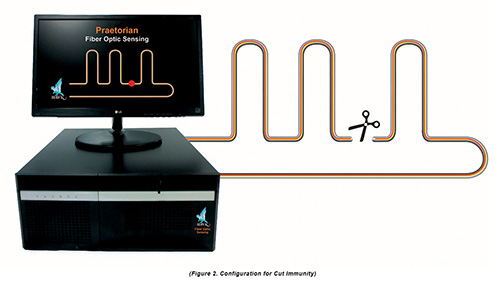The Ultimate Overview to Fiber Optic Security Systems for Your Business
In an era where safety worries are critical for companies, recognizing the ins and outs of fiber optic technology can be transformative. This guide details how incorporating fiber optic safety systems not just enhances information defense but also uses benefits like resistance to interference and real-time surveillance abilities.
Comprehending Fiber Optic Modern Technology

The core of a fiber optic cable is composed of a thin glass or plastic facility, bordered by a cladding layer that mirrors light back right into the core. Single-mode fibers are created for long-distance transmission, while multi-mode fibers are suitable for shorter distances, typically utilized within buildings.
Fiber optics are not only faster but also extra safe and secure than typical wiring. Their intrinsic resistance to electromagnetic interference and the problem of using the signal without discovery make them a recommended option for organizations prioritizing data stability and safety and security. As organizations significantly count on secure and efficient communication systems, recognizing fiber optic modern technology comes to be necessary for informed decision-making.
Key Benefits of Fiber Optic Safety
When considering safety and security options for a company, the benefits of fiber optic systems are particularly compelling. Primarily, fiber optic technology provides extraordinary data transmission rates and bandwidth capacity, making it ideal for managing high-resolution video feeds from surveillance cameras. This ability guarantees that safety personnel get real-time information, enhancing overall reaction times to possible safety and security hazards.
Moreover, fiber optic cables are inherently immune to electromagnetic disturbance, which can jeopardize the stability of conventional copper-based systems. This resistance guarantees that the information transmitted remains protected and nonstop, giving an extra dependable protection infrastructure. Furthermore, optical fiber are less prone to physical damages, as they are made from glass rather than steel, decreasing upkeep expenses and downtime.
Fiber optic systems supply enhanced cybersecurity functions, including security capabilities that protect delicate information from unapproved accessibility. Collectively, these benefits make fiber optic protection systems a robust choice for companies looking for to improve their safety actions.
Setup Process and Considerations
Thinking about the intricacies entailed, the setup procedure of fiber optic safety systems needs mindful planning and execution. The preliminary step involves a detailed website assessment to determine optimum areas for cabling and equipment. This analysis must consider ecological variables, existing facilities, and prospective susceptabilities.

In addition, the setup should abide by neighborhood structure codes and market requirements. This might consist of coordinating with various stakeholders such as structure supervisors, IT teams, and safety and security personnel to make sure smooth combination with existing systems.
Post-installation, rigorous testing is necessary to verify system performance and determine any kind of issues that might arise. By focusing on these factors to consider throughout the installment process, services can make sure a durable and efficient fiber optic safety and security system that satisfies their details safety needs.
Latest Advancements in Fiber Optic Safety And Security
Current improvements in fiber optic innovation have actually substantially improved the capabilities of security systems for companies. Among one of the most noteworthy innovations is the combination of fiber optic sensors go that can spot resonances and intrusions along the boundary of a center. These sensing units supply real-time monitoring, allowing quick reaction to prospective breaches.
Additionally, the growth of distributed fiber optic sensing modern technology enables the continual monitoring of huge locations with a single fiber wire. This method not just decreases installation prices yet also enhances the dependability of checking systems by eliminating the demand for several, separate sensors.
Moreover, improvements in multiplexing methods have actually enabled organizations to send vast amounts of information over fiber optic networks, boosting the abilities of video clip security systems. High-definition video feeds can currently be sent over lengthy ranges without loss of high quality, making certain that protection employees have access to clear and workable details.
Finally, using synthetic intelligence (AI) together with fiber optic systems is reinventing danger discovery. Read More Here AI formulas can analyze information from fiber optic networks to identify unusual patterns or behaviors, permitting positive safety actions. These technologies collectively represent a substantial jump forward in fiber optic safety and security technology.
Selecting the Right System for Your Business
Selecting the proper fiber optic protection system for your company is essential for making certain optimum protection and comfort. To make an educated option, evaluate your particular safety needs, considering elements such as the dimension of your premises, the nature of your operations, and potential susceptabilities.
Begin by evaluating the level of safety and security called for; for circumstances, high-risk environments may require sophisticated systems with integrated security and invasion detection capacities. Next, take into consideration scalability; as your service grows, your safety and security system must be qualified of expanding to suit enhanced needs without substantial overhauls.
Furthermore, explore the reliability and efficiency of various systems. Look for service providers with established online reputations and customer testimonies that vouch for their solution high quality. It's also a good idea to make inquiries regarding the technology's compatibility with existing facilities, making certain a seamless combination procedure.
Final Thought
In verdict, fiber optic protection systems offer a robust service for enhancing service security facilities. The assimilation of high-speed data transmission, resistance to electromagnetic disturbance, and advanced tracking capacities significantly enhances total protection (fiber optic security system). By comprehending the technology, acknowledging its advantages, and thinking about the setup process, companies can make educated choices. The most up to date technologies better reinforce the effectiveness of these systems, ensuring that organizations continue to be safe and secure and adaptable in an ever-evolving danger landscape.